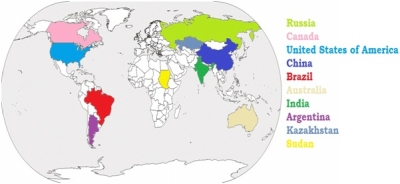
Covering an expanse of over 6.6 million square miles, Russia is the world’s largest country by landmass, beating out runner-up Canada by around 2.8 million square miles. It includes nine different time zones and shares land borders with 14 neighboring countries. Russia’s origins began with the Viking establishment of Kievan Rus in the 9th century. It expanded under the leadership of Viking chieftain Rurik and his ancestors but was broken up by Mongol invaders in 1237. Beginning with the Grand Duchy of Moscow, which was less vulnerable to Mongol attacks due to its remote, forested location, the remnants of Rus unified and expanded, most notably during the reign of Ivan the Terrible from 1533 to 1584. As its first official tsar, Ivan established the central Russian state and doubled its size by conquering the regions of Kazan, Astrakhan and Siberia. It expanded into the third largest empire in the world by the 1700s, and as the post-revolution Russian Soviet Federative Socialist Republic, it was the largest part of the Soviet Union. With the break-up of the Soviet Union, Russia, also known as the Russian Federation, was officially established on December 25, 1991.
China underwent a period of modernization during Mao’s rule, including improvements to its health care system, which increased life expectancy dramatically. At the same time, Mao urged people to have larger families because he believed that population growth would result in the empowerment of the country as a whole. During Mao’s reign, from 1949 to 1976, China’s population grew from approximately 540 million to 940 million. In order to curb China’s overpopulation, the one-child policy was instituted in 1979 and has slowed the country’s exponential growth, but the population has still climbed to over 1 billion more than the third-ranked United States (313 million).
China may not hold the “most populous” title for long, though. The U.N. predicts that in the next 15 years, China’s and India’s populations will both reach nearly 1.5 billion. At this point, China’s population will begin to decrease, due to an aging population without a sufficient birth rate to sustain growth, and India’s will continue to climb.
Credit : History.com
Picture Credit : Google




